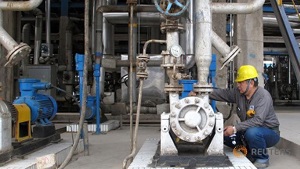OPEC output curbs could be undone by China slowing crude storage
The opinions expressed here are those of the author, a columnist for Reuters.
(Reuters) The sharp drop in China's crude oil imports in October can be ascribed to a combination of factors, but one of them should be a red flag to OPEC, threatening the success of any deal to curb production.
Crude imports slumped to 6.78 MMbpd in October, the lowest since January and down from a record high of 8.04 MMbpd in September, according to customs data released on Tuesday.
Several reasons were cited for the drop, among them lower buying by smaller, independent refiners known as teapots, as they have come close to exhausting their official crude import quotas for the year.
Another potential factor was the extended national day holidays early in October delaying the off-loading of cargoes, but these factors are unlikely to alone account for imports dropping by 1.26 MMbpd from September to October.
It's most likely that the bulk of the slowdown was because of lower commercial and strategic stockpiling of oil, and this is also likely related to higher prices.
China doesn't release stockpiling data on a monthly basis and only occasionally updates the amount of crude it has in strategic storage.
The best way to gain an idea of how much crude is flowing into storage is to add together net crude imports and domestic output and then deduct refinery throughput.
While data on refinery throughput and domestic crude production for October won't be available for a couple of weeks, figures for the third quarter show China was most likely stockpiling at a rapid pace.
The difference between net crude imports added to domestic output, and refinery throughput was 1.169 MMbpd in September, 1.132 MMbpd in August and 595 Mbpd in July.
Given that crude imports fell by 1.26 MMbpd in October from September, it's possible that very little crude flowed into stockpiles in October, assuming that refinery throughput and domestic crude production were more or less steady.
Price-sensitive China stockpile buying. If this is the case, it also suggests that China's purchases for storage are relatively sensitive to price.
The Brent and Oman crude prices were weakening in June and July, the time frame for when August and September cargoes would have been booked.
However Brent jumped almost 22% from its close on August 2 to the close on August 18 as members of the Organization of the Petroleum Exporting Countries (OPEC) started to once again talk publicly about limiting output in order to boost prices.
This is also the timeframe when many cargoes for October delivery in China would have been booked, suggesting that the sharp jump in prices dampened appetite for storage purposes.
Crude prices rallied again after stabilizing in September, with Brent closing at $53.14/bbl on October 10, its highest so far in 2016, as OPEC appeared closer to agreeing production cuts at a meeting to be held later this month.
This suggests the potential for China's imports in November to remain soft, as the authorities may be prepared to see if OPEC actually delivers a meaningful cut to production, or whether it disappoints once again.
The problem for OPEC is simply this. If it agrees an output cut and this does boost prices to the point where China decides to curb imports for stockpiling, the risk is that any cut to production is merely matched by a corresponding drop in Chinese imports.
It's unlikely that OPEC will be giving much thought to the risks around Chinese crude demand for storage, but the mere fact that all OPEC's hard work in grafting an agreement between disparate parties could be undone at the stroke of a pen in Beijing underlines just how hard it is to control the oil market these days.
By Clyde Russell; Editing by Richard Pullin







Comments